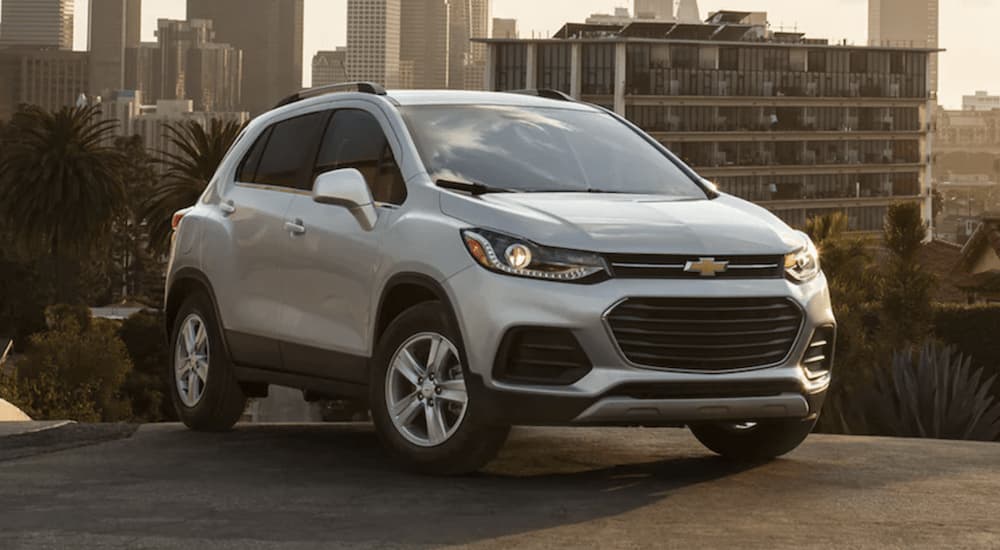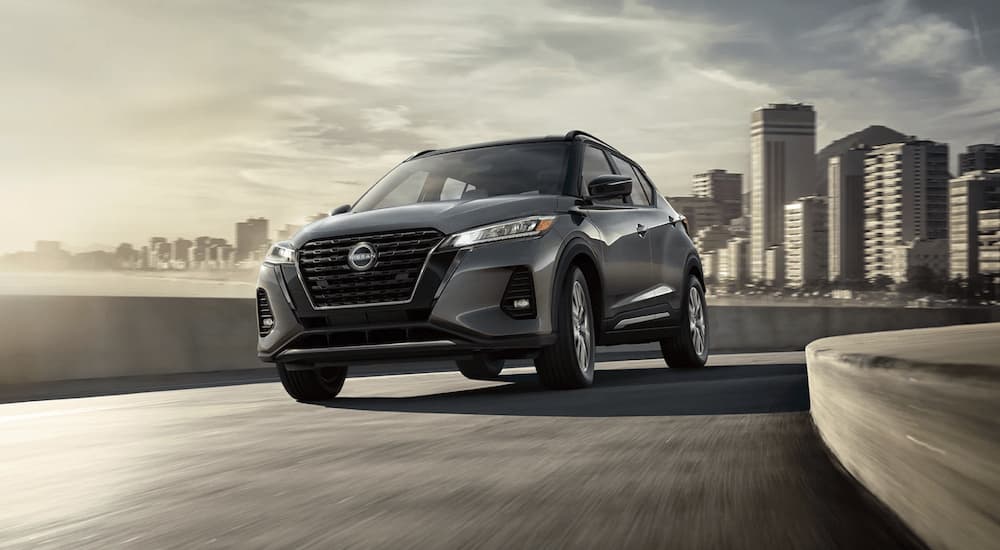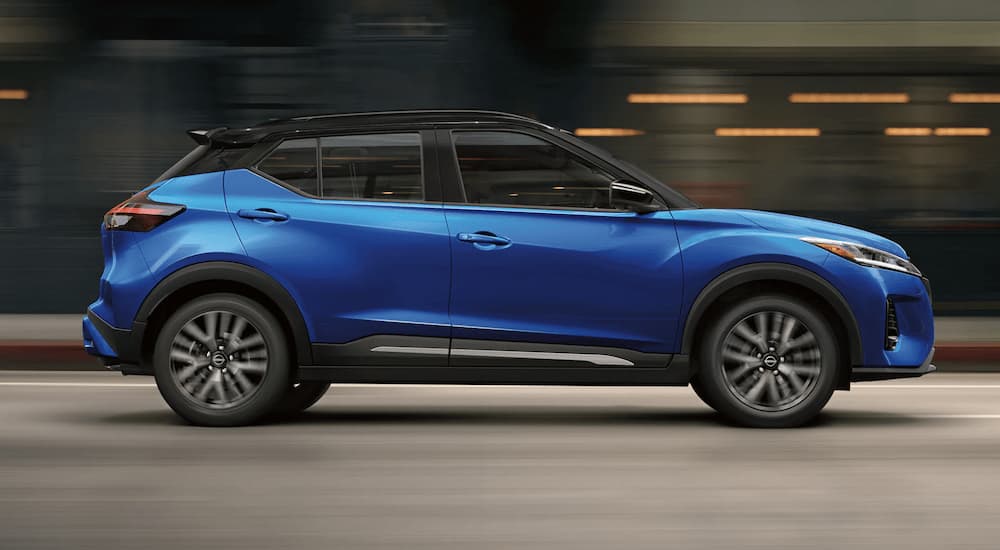First-time buyers are in a unique position to take advantage of a new vehicle marketplace that is loaded with affordable options. Consider vehicles like the 2021 Nissan Kicks vs 2021 Chevy Trax–these fun, affordable crossovers deliver on style and value, with trim ranges that consider all different budgets, including tight ones. Is one of these little utes just right for you?
But we’re getting ahead of ourselves because some first-time buyers still aren’t clear on what trim ranges are or, for example, how to discern one version of a Nissan Kicks from another. Which one presents the best value? Should you spring for the high-end trim or buy the base model and purchase an equipment package? All these questions get easier when you have a set of guidelines to follow.
After determining your budget, perhaps the most important step in the car buying cycle is conducting research. Taking time to understand all your options and learning all the ancillary factors that go along with vehicle ownership, such as insurance, registration, and ongoing maintenance, are part and parcel of the process. It sounds complex, but investing time to prepare for your purchase will make things go a lot more smoothly.

Stage #1: Research Vehicle Categories and Sizes
Have you started your new vehicle search? If not, be prepared for a wave of overwhelm. There is a dizzying assortment of vehicles in every category. You’ll find sedans, SUVs, and even pickup trucks in a wide array of sizes and types. Clicking through to a specific vehicle’s web page often reveals multiple trims, and within each trim are optional bundled equipment packages. Where to start?
Here’s our suggestion: First, decide on body style. Do you want a car (sedan/hatchback/coupe), an SUV/crossover (the terms are often used interchangeably; both have similar bodies, but an SUV sits on a truck platform and a crossover sits on a car platform), or a pickup? Choosing your preferred body style will help you target your search, which is a big time saver. Also, most buyers tend to favor one body style.
Next, decide on a size. Sizes range from subcompact to /full-size. For example, within the Nissan SUV lineup, the subcompact Nissan Kicks is the smallest, and the full-size Nissan Armada is the biggest. Your budget will dictate size to an extent, but sometimes there is pricing overlap between models. Consider this: the most expensive Kicks, the SR with the Premium Package, costs about the same as the base model Rogue S, so the question is, do you want a fully-loaded Kicks or a base model Rogue?
Once you’ve zeroed in on a size, you’re moving on to making more detailed decisions. This is the stage where you’ll apply personal preference. Research all the available models in your preferred body style and size (eliminate models you can’t afford) and take some time to view photos online to determine your preferred style. Since style is so personal, it’s best to go with your gut and add any vehicle that catches your eye to the list of potential options.
Stage #2: Trims, Equipment Packages, and Special Editions
You’ll know you are ready to move on to this stage when your list of candidates is five or fewer models that fit within your budget limits. Starting with more potential winners will lead to confusion, and you’ll end up deep in the weeds and very confused. If you can’t narrow it down, it’s best to return to stage one and do a little more general research. For everyone else, it’s time to dig into trims and specifications.
Have you considered what you’re looking for in a new vehicle? For some, safety is critical, but for others, fuel economy or technology top the list. Your job now is to make two lists: the first list contains your must-have features. The second list is made up of optional nice-to-have features. Next, filter each prospective vehicle through your first list and eliminate the ones that don’t offer the features you require.
At this point, your list should be whittled down to 2-3 vehicles. Now it’s time to dig into trims. We’ll use the 2021 Nissan Kicks to illustrate the process. The Kicks comes in three trims–the base S, the mid-range SV, and the top-of-the-line SR. Prices range from just under $20,000 to just over $22,000. A deep dive into the specifications for each trim reveals a slow-build of price and features that runs from budget-focused (S trim) to upscale (SR trim).
Feel free to play with the manufacturer’s build tool to discover all the available configurations or compare each trim’s specs to help you pick out the best trim based on your list of nice-to-haves. Be sure to read all the details and don’t assume that every model offers the same thing. For instance, like all Nissan models, the Kicks features standard driver-assist safety systems across the entire trim range. However, competing models like the Chevy Trax do not have many driver-assist features even on their top trims. These details may help you narrow down your options if you discover that some of their desirable features are only available on trims outside your price range.
Stage #3: Understand Extra Ownership Costs
As you progress through stage two, the final one or two vehicles will become clear. At this point, it’s time to investigate the entire ownership value proposition. Call your insurance company and get current rates. Take a close look at warranty coverage and determine the manufacturer’s suggested maintenance intervals. This process allows you to calculate the actual cost of ownership, and it’s an important step for first-time buyers.
You’ll want to reach out to an authorized dealer to schedule a test drive and speak to an in-house financing pro. This is where you’ll learn about available rebates or special finance or lease programs tailored to first-time buyers. You usually don’t need to go down the rabbit hole of finding a different lender, because nine times out of ten, a certified dealer will have access to the best rates. What can you do to prepare for your visit? Know your credit score and decide on a down payment.
One important thing to keep in mind–many reputable dealers don’t haggle. Though you may have heard horror stories from friends and neighbors, if you choose the right dealer, your purchase process will be transparent, stress-free, and efficient. Also, most dealers publish their inventory with photos, so you can peruse their offerings ahead of your visit to save even more time. In fact, some dealers let you complete the entire transaction online.
As a first-time buyer, it’s easy to get lost in the details, but it’s OK to put your trust in the sales consultant. Be honest about what you don’t know, and don’t be afraid to ask questions. Dealers love first-time buyers because, for most, they’re out to earn your business for life. A great first impression goes a long way toward building customer loyalty, so expect white-glove service and a pressure-free purchase process.
Putting it All Together
Somewhere along the line, we forgot that buying a new car is supposed to be exciting. This is especially true for first-time buyers. Sure, you might have a limited budget, but you can still drive off the lot as the first owner of a brand-new car. That new car smell is intoxicating. Nothing beats sliding behind the wheel of a pristine vehicle that you get to call your own. Don’t miss out on the fun by allowing yourself to become overwhelmed. Instead, relax, do your research, and discover what you truly want and need in a new car. The rest is easy–and lots of fun if you do it right. Happy shopping!





